
MAY CONTAIN NUTS

Search Shorpy
SHORPY ART

Framed or unframed, desk size to sofa size, printed by us in Arizona and Alabama since 2007. Explore now.
Join and Share
Ad-Free Shorpy
Shorpy is funded by you. Patreon contributors get an ad-free experience.
Learn more.

Recent comments
- Recent view
- Hudson’s Big Store
- Say what??
- Grapes?!
- A Beautiful Moment
- Such joy
- Bethune-Cookman University today...
- Yellow sky at morning
- Side Winder
- Air Quality?
- Sojourner Truth riot
- None were so blind(ed)
- The less famous sister
- Good ol' days?
- Rise and Fall
- Goo Goo Ga Joob
- Ticket Retention
- Not the only one
- Vagaries of War
- Killed by Amtrak
- Back to the Future
- Wanted --
- If you can't stand the light
- Centralized Traffic Control, I believe
- What's really happening
- Heckuva remote control!
- Sometimes — Things Go Bump!
- I SEE THE LIGHT
- Union Switch and Signal Company
- Get That Light Out Of My Eyes
Member Photos
The Shorpy
Print Emporium
Print Emporium
Search Shorpy
Search results -- 30 results per page
- Dandruff Avalanche: 1903
- ... yacht. - Dave]
The Constitution was a Train Wreck The Constitution was a contender to defend the 1903 America's ... Posted by Dave - 03/30/2023 - 8:52pm -
![Dandruff Avalanche: 1903 May 1903. New York. "Newsboys at Greeley Square." Our title is a word salad plucked fresh from this 8x10 inch glass negative. Detroit Photographic Company. View full size.
Headline NewsAMERICANS ON MONT BLANC CAUGHT IN AVALANCHE!
Greeley SquareGreeley Square is a triangular park bounded by Broadway and 6th Avenue between West 32nd and 33rd Streets, two blocks south of Herald Square. It is named for one of the most eccentric figures in American history and contains a seated statue of him.
Horace Greeley (1811-1872) founded the New York Tribune, which by 1850 was the nation’s highest-circulation newspaper. One of the founders of the Republican Party, he was a continual irritant to Abraham Lincoln, not just because he thought he should dictate policy, but because he kept flailing among positions, supporting ‘peaceable secession’, then a strong war effort, immediate abolition, then a negotiated settlement with the South. Always enthusiastic, there was hardly any fad or ‘reform’ that he did not advocate at one time of another. (He was for, then against, women’s suffrage.) He supported Reconstruction but signed Jefferson Davis’s bail bond. Breaking with the Republican Party, he was nominated for president in 1872 on a fusion ticket with Democrats, lost badly to Grant, and died a month later.
He is perhaps best remembered for “Go West, young man,” a phrase he denied coining. (It probably originated with John B. L. Soule, an Indiana publisher.)
6th Avenue ElOn the right side of the Shorpy photo is the 33rd Street station of the long-vanished 6th Avenue Elevated. The building is the Union Dime Savings Bank, also vanished (though it outlasted the El by 20 years).
In center of the image below, you are looking straight down the sidewalk in the 1903 photo.
No, thank you, I already have oneI notice our dapper pedestrian in his bowler (derby?) isn't being petitioned to purchase a newspaper from any of the several vendors around him, no doubt because he is already carrying a newspaper. Reminds me of men or women who wear wedding rings when they're not married.
Old Style HumorDad (1919-1997) was a mixture of Jackie Gleason, Danny Thomas, Red Skelton, and Spike Jones. One of his many quips that he would shout out as he did household chores was:
Extra! Extra! Read all about it! 20,000 soles found dead in a shoe factory!
The New Coke!Prevents baldness and clear thinking.
Later known as Herald SquareThat's the Sixth Avenue El in the photograph. 1903 places during the period when electrification of the line was new and the first subway was under construction.
Today (from a different angle), courtesy of Wikimedia:
The ShiningSmall detail; But every adult in the picture appears to have a shine on their shoes.
Even the guy sitting on the right holding a stick, his shoes are a little rougher than the others, but there is still evidence of a shoeshine on the tip of the toes.
Constitution wrecked?The headline about the Mount Blanc Avalanche is interesting. I wonder if they're referring to the ship Old Ironsides or some piece of legislation the paper believes wrecks our country's most precious document. I'll vote for the USS Constitution as in 1903, Charles Francis Adams III, descendant of two US Presidents and in his role as president of the Massachusetts Historical Society at the time, requested Congress rehabilitate Old Ironsides and place her in active service. That would happen 22 years later when her restoration began.
[The Constitution was a racing yacht. - Dave]
The Constitution was a Train WreckThe Constitution was a contender to defend the 1903 America's Cup. She lost to the 1899 winner Columbia, principally owing to the ineptitude of her crew. Columbia went on to beat Sir Thomas Lipton's Shamrock II in the 1903 Cup.
The Frank SlideCanada's deadliest avalanche, known as the Frank Slide, occurred at the end of April, 1903. I wonder if that warranted a headline?
[As noted below, the headline is about an avalanche on Mont Blanc in the Alps. - Dave]
If I thought the Frank Slide was the subject of the headline pictured, I wouldn't have wondered if it warranted a headline of its own. Still loving my daily Shorpy time travel.
(The Gallery, DPC, Kids, NYC, Railroads)](https://www.shorpy.com/files/images/SHORPY-4a55278a1.thumbnail.jpg)
- Hotel Velvet: 1904
- ... Publishing Company. View full size.
Watching the train roll by As youngsters we would watch the freight trains roll through ... were often 100 cars or more longer. I was told once that a train of 100 cars was over a mile long. We just amused ourselves counting them. ... Posted by Dave - 08/14/2012 - 11:15am -
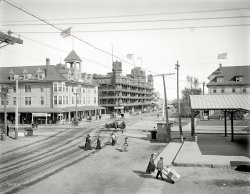
- The Lonely City: 1940
- ... there but after several modifications.
Two Elevated Train Lines for the Price of One The four tracks in the foreground belong to ... The Sixth Avenue tracks were demolished after the end of train service in 1938; the Ninth Avenue tracks we see here were torn down in ... Posted by Dave - 10/26/2022 - 12:00pm -
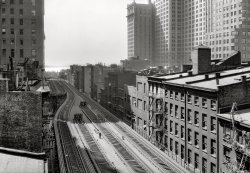
- Train Wreck: 1909
- Wrecked Pennsylvania R.R. car on tracks south of Brunswick Street. Jersey City, N.J. November 6, 1909. View full size. George Grantham Bain Collection.
Hats Interesting how people are wearing hats indoors, too.
4 killed in this wre ... Posted by Dave - 09/07/2011 - 6:11pm -
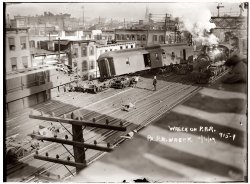
- Cu Cu Train: 1942
- November 1942. "Bingham Canyon, Utah. Ore trains on a trestle bridge above an open-pit mine of the Utah Copper Company." Photo by Andreas Feininger for the Office of War Information. View full size.
Further on Old Fan Excerpted from: Th ... Posted by Dave - 10/23/2013 - 4:39pm -
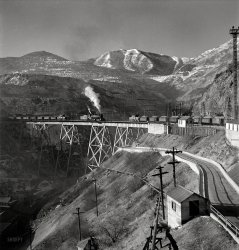
- California Here I Come: 1943
- ... Unfortunately, the book is in Black & White.
That train isn't moving anytime soon! The train still has a blue flag hanging on it. That means that there is still ... Posted by Dave - 07/17/2012 - 10:04pm -
![California Here I Come: 1943 Santa Fe freight about to leave for the West Coast from the Corwith Yard at Chicago. View full size. 4x5 Kodachrome transparency by Jack Delano. This is the freight Jack accompanied from Chicago to California in March 1943, taking many pictures along the way for the Office of War Information.
CaliforniaIs this Delano still alive?
Laurent Wiame from Switzerland...
[Jack Delano died 10 years ago at the age of 83 - Dave]
Thank youThank you for all the amazing color pictures by Jack Delano...
California or BustI hope you have all of the pictures from Frank's trip from Chicago to LA, I certainly would love to see them. So Frank worked for the war dept? He sure was lucky to be able to travel across the country for his job and getting paid for it.
Iron Horse at WarHe wrote a book entitled the "Iron Horse at War" which chronicled this trip and also contained many railroad photos from other parts of the country. The book is out of print but might be found on E Bay. Unfortunately, the book is in Black & White.
That train isn't moving anytime soon!The train still has a blue flag hanging on it. That means that there is still someone working on it. Each worker puts a blue flag on the front end of the train (or on the track ahead of the train) and ONLY that man can remove it. Once all blue flags are removed, the train can then proceed.
Jack DelanoMany thanks for these fabulous photographs. Just stumbled across them ... Delano was an artist of the finest caliber, and you honor him by posting these for future generations to enjoy. Excellent work.
Jack from Chicago
(The Gallery, Kodachromes, Chicago, Jack Delano, Railroads)](https://www.shorpy.com/files/images/1a34699uuu.thumbnail.jpg)
- It's a Small Train: 1951
- September 1951. "Walt Disney oiling parts of the locomotive of his scale model steam railroad, the Carolwood Pacific Railway, in the backyard of his house in Los Angeles." Medium-format nitrate negative by Earl Theisen for the Look magazine assign ... Posted by Dave - 01/07/2015 - 8:00am -
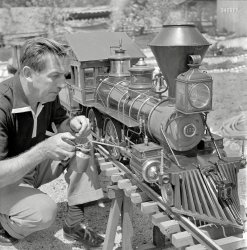
- Train Christening: 1929
- ... water on the locomotive of a new Pennsylvania Railroad train this morning at 11 o'clock in the Union Station and christen it 'The ... Posted by Dave - 04/05/2013 - 12:06pm -
![Train Christening: 1929 July 14, 1929. Washington, D.C. "Ten-year-old Ellen Page Eaton will break a bottle of Potomac River water on the locomotive of a new Pennsylvania Railroad train this morning at 11 o'clock in the Union Station and christen it 'The Senator.' Little Miss Eaton is the daughter of John Eaton, crack engineer of the railroad, who is veteran of 28 years." More of the festivities first glimpsed here. Harris & Ewing Collection glass negative. View full size.
Ready when you are, CBIt looks like this might not have been the first take.
WhoopsYeah, looks like that Potomac River water didn't quite make it to the locomotive! Oh well, the thought was there.
Shoes and aplomb!I like the gent to the right of little Ellen Page Eaton, holding his hat with aplomb and trying become the center of attention. And look at his fashionable shoes!
As Jimmy Durante would say"Everybody wants to get into the act." The woman behind Miss Eaton and to her right in the picture is quite intriguing. And lovely. And elegant in her cloche hat and beads. The only thing prettier than a pretty woman is a pretty woman with a pretty hat.
Senator David I. WalshThe gent at the left-end shaking hands looks to be Senator David I. Walsh, of Massachusetts. Below is the final bit of the article from the previous post.
Washington Post, July 14, 1929.
… Among those who will attend the ceremonies are Senator David I. Walsh, of Massachusetts, District Commissioner Proctor L. Dougherty, Charles W. Darr, president of the Washington Chamber of Commerce, and the Rev. Shera Montgomery, chaplain of the House or Representatives. Alan B. Smith, general passenger agent of the railroad, who came here from Cleveland on July 1, is in charge of arrangements. Secretary of the Navy Charles Francis Adams and Secretary of Commerce Robert P. Lamont also have been invited to attend.
[The man between the hand-shakers is Charles Darr. - Dave]
(The Gallery, D.C., Harris + Ewing, Railroads)](https://www.shorpy.com/files/images/SHORPY_35484a.thumbnail.jpg)
- Strangers on a Train: 1928
- "Southern Railway, interior of car," circa 1928 in or near Washington, D.C. National Photo Company Collection glass negative. View full size.
Generations Interesting to think the elderly gentleman on the left might be a Civil War vet--a ... Posted by Dave - 09/04/2012 - 12:03pm -
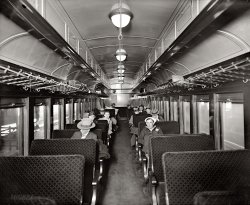
- Michigan Avenue: 1941
- ... turn on red.
Sunday morning Where IS everybody?
Train of Thought Looks like somebody's model train layout. And they did a really good job with all the period correct cars ... Posted by Dave - 11/15/2011 - 6:38am -
![Michigan Avenue: 1941 Chicago, July 1941. "Stop light, Michigan Avenue." 35mm nitrate negative by John Vachon for the Farm Security Administration. View full size.
N. MichiganThis looks like North Michigan at the foot of the "Magnificent Mile," perhaps. The barely-seen white stone structure at the top of the photo looks like the Water Tower, sole survivor of the Great Fire of 1877.
Water Tower PlaceThere's not many places were Michigan Avenue jogs to right as shown above. And the building in the background is one that is particularly famous: the Water Tower. So this appears to be the intersection of Michigan Avenue and Superior Street (currently one-way, heading east). None of the buildings other than the Water Tower still stand.
The most shocking for me is seeing all those nice grass sidewalk lawns in the midst of an area that is now very densely urban.
BustlingWhat are you all talking about? I count 15 people not in cars. Now that's crowded!
Taxi questionI've noticed in the pictures of New York cabs and now Chicago had peculiar cutaway fenders as well as open rear roofs. What's up?
[The low-maintenance fenders and landaulet roof were design features of the Checker Model A. - Dave]
So PeacefulLooking at this photo you would never believe Europe & Asia were in the middle of a war.
Hanging a leftI find it interesting that the Left Turn Only lane has traffic turning before the actual light stanchion. Would it be safe to assume the street that traffic was turning onto was a one-way street? If not, it might wreak havoc if the oncoming traffic was making a right turn on red.
Sunday morningWhere IS everybody?
Train of ThoughtLooks like somebody's model train layout. And they did a really good job with all the period correct cars and billboards. It just doesn't look real -- perhaps more because of the aerial angle than anything else.
"Gasolene"For a slimmer carbon footprint.
FrozenWhat an interesting affect; this photo looks like it was taken of a diorama of some sort. There is a feeling that one could just reach down and rearrange those model cars at will. Makes one feel like Rod Serling! I think it is accentuated by the perceived lack of people; there are only seven visible.
Gasolene?I've seen it spelled this way in the Caribbean, but never here in the US. Was this an accepted spelling at the time, or something Cities Service did to distinguish itself from the rest of the crowd?
Kist againStar-kist yesterday (Air Race) and Sunkist today. Is there a theme starting here?
ChangesI found it on Streetview, luckily. Everything is different except the ornate little building in back.
VestigesAbout the only thing left in this picture today is the old Chicago Water Tower, the masonry building the bottom of which is partially visible at the top of the photo. That upper street is East Chicago Avenue.
This is not my Michigan AvenueJudging by the clock on the Sunkist sign, it's 3:05 p.m. And for the lack of people, I'm guessing that North Michigan Avenue was not the hot shopping area. South State Street had Carson's and Field's with their large stores. Watch out -- no traffic lanes. That gas station is long gone, too bad, it's a nice looking building. Walgreen's is now on the the east side of Michigan. And that's the famous Water Tower, cut off at the top of the image.
Late Model and UpscaleIt seems that the majority of the cars are late model and upscale.
Michigan & SuperiorThis view is taken from the intersection of Michigan Avenue and Superior Street, looking north toward Chicago Avenue, where Michigan bends to the right. In the upper right hand corner you can see a sliver of the famous Chicago Water Tower (W. W. Boyington, architect, built 1869), the best known survivor of the Great Chicago Fire of 1871. Needless to say, other than the Water Tower itself, every single building in this picture has been demolished.
East Superior StreetThe intersection below is Superior Street and Michigan Avenue, and the street to the north is Chicago Avenue. You can see the base of the Old Water Tower at the top of the image.
Miracle MileMarvelous image. Very likely we're looking north on Michigan, with Chicago Avenue intersecting near the top. What appears to be the base of the Chicago Water Tower is at the top, where Michigan kinks just a click to the NE. Charmette's Restaurant was located on the SW corner of Michigan and Chicago for many years. Spent many hours there in the late 50s, often in the company of a pretty girl from Navy Pier. Were we able to peek west on Chicago about three blocks, we would no doubt see men dancing with their wives.
Needs some careful weathering.As a diorama-maker myself, I'd say one thing that makes this scene feel less-than-realistic is the near-uniform grayness of the streets (especially for longtime Shorpy fans who are used to seeing road apples and horse urine in many of the older photos). This looks like brand-new pavement. If I were crafting this one, I'd definitely add oil stains, more tire tracks, maybe a pothole or two, and more manhole covers. While I was at it, I'd do something about the turf; it definitely looks fake. By the way, I love this picture. It'll be my desktop wallpaper for a while.
The best photoof a real photo imitating a model builders skill, and can this be the cleanest street in the world?
Double-decker busI doubt there are many cities in the US still using double-decker buses on regular commuter routes. I know of only a few in California. Some cities have them for tourist use including NYC and Las Vegas. I think they might be a better option than the long accordian buses that take up so much street space.
AfterthoughtI'd bet the reason for the odd and decidedly unsafe configuration of the left turn lane is a desire to avoid relocating the pre-existing traffic signal fixture. This is a workaround that would certainly not meet today's engineering standards, but reflects the evolving practice of the day.
I've seen the "gasolene" spelling from the turn of the century to the '20s, but never this late. At some point, I think there might have been a desire for a spelling consistent with kerosene.
Totally changedI lived two blocks west of here for 17 years starting in the late '70s, and still didn't recognize the location until I saw the old water tower. The lots with Sunkist signs and gas station had a series of small one-story buildings when I lived there, including a McDonald's and later a Banana Republic. For years there was also Evan's furs in the center of that block, a four-story building.
At Huron and Michigan (the intersection behind the photographer, not seen here) we had a Woolworth's! Complete with Luncheonette counter the length of the store. At Chicago Ave and Michigan, we had Wag's, the coffee shop of Walgreen's. My co-workers and I used to have lunch at Wag's when we worked at the Playboy (Palmolive) building.
Michigan Ave wasn't much of a shopping street until the late 1970s, when Water Tower Place went up. Just offices, hotels, apartments, and a few very upscale shops like furriers and jewelers (and Woolworth's!) The ad agencies were in this area. There were some great dive bars on Ontario, including the Inkwell, where all the Playboy people went after work.
More PeopleI got to this one a few days late but my old eyes (with a magnifier app) pick out 20 folks on the sidewalks here.
Clockwise from lower left:
2 at lower left
2 behind a car at the front door of the Gasolene station
7 strolling in front of Walgreen's
1 at the curb infront of Walgreen's, talking to someone in the car parked there
2 on the bench at the corner, facing the cross street
2 on the far side of the cross street
1 crossing at the crosswalk
3 on the opposite side of Michigan Ave (hard to distinguish but I see 3 shadows on the pavement).
Please correct me if I'm mistaken, or if you find even more.
(The Gallery, Cars, Trucks, Buses, Chicago, Gas Stations, John Vachon)](https://www.shorpy.com/files/images/SHORPY_8a32786a.thumbnail.jpg)
- Slow Train Coming: 1943
- March 1943. "Gallup, New Mexico. A train on the Atchison, Topeka & Santa Fe between Belen and Gallup, New ... Posted by Dave - 10/02/2015 - 11:15am -
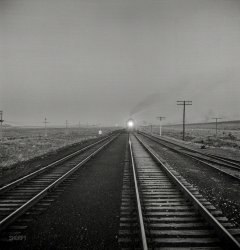
- Night Train: 1943
- March 1943. "Barstow, California. A view of the Atchison, Topeka & Santa Fe yard at night." Medium-format negative by Jack Delano. View full size.
2-10-2 "Santa Fe Type" The Santa Fe steam locomotive 1691 in the photo, is ... Posted by Dave - 01/07/2013 - 3:46pm -
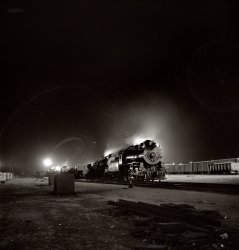
- Train in Vane: 1905
- ... such otherwise mundane and utilitarian purposes such as train stations, post offices etc.
What was the need for such incredible ... Posted by Dave - 07/07/2021 - 1:17am -
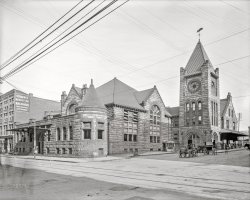
- Sanitary Train: 1917
- 1917. "American Red Cross sanitary railroad car." The "sanitary trains" of World War I played a major role in the delivery of relief supplies and medical care to Allied prisoners in Europe, as well as their repatriation after the Armistice. Harris ... Posted by Dave - 08/05/2012 - 7:57pm -
![Sanitary Train: 1917 1917. "American Red Cross sanitary railroad car." The "sanitary trains" of World War I played a major role in the delivery of relief supplies and medical care to Allied prisoners in Europe, as well as their repatriation after the Armistice. Harris & Ewing Collection glass negative, Library of Congress. View full size.
Same Man?Is that the same man getting the physical in the previous photo? It sure looks like him!
[Hm. I think you're right! - Dave]
Close...Pretty close, but not the same. Look at the shape of the ear lobe.
[Hm. I think you're right! - Dave]
Being ThereI am especially impressed by this photo- -- it feels as though the viewer has been transported through time and this man is going to get up and go about his business any second. You can practically hear him breathing. Amazing.
(The Gallery, Harris + Ewing, Railroads)](https://www.shorpy.com/files/images/10242a.thumbnail.jpg)
- Long Train Running: 1900
- Circa 1900. "Steel viaduct over Des Moines River, Iowa -- Chicago & North Western Railway." 8x10 glass negative by William Henry Jackson. View full size.
The Kate Shelley High Bridge Finally a post just outside of my hometown! This ... Posted by Dave - 10/20/2016 - 5:23pm -
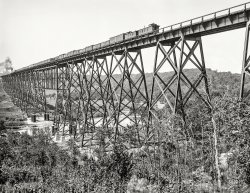
- Long Train Going: 1943
- ... block of about 8 passenger cars deadheading in the freight train, just to the left of the signal. Not unheard of, but I would think ... Posted by Dave - 03/20/2013 - 1:46pm -
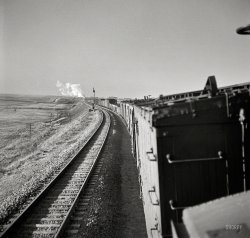
- The Train in Pensacola (Colorized): 1906
- A closer view of the train in Pensacola 1906, colorized. View full size.
Impressive I bow ... Posted by RR Jim - 07/26/2011 - 2:38pm -
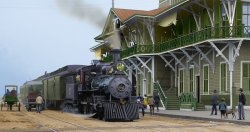
- The H Train: 1919
- ... Ho" over here . He definitely does not need the H Train to get around.
From the front page of the Los Angeles Herald of 12 ... Posted by Dave - 10/01/2017 - 8:20pm -
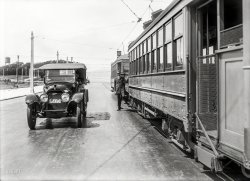
- Dudley Street Station: 1904
- ... left of the picture, in front of the "Calvary Cemetery" train. presumably there's a high chimney off to the right behind the ... as a bus station:
View Larger Map
Train Station of the Rising Sun I wonder what that sign next to the exit ... Posted by Dave - 08/05/2012 - 3:10pm -
![Dudley Street Station: 1904 Boston, Massachusetts, circa 1904. "Dudley Street Station, Boston 'L' Railway." 8x10 inch dry plate glass negative, Detroit Publishing Company. View full size.
That Shadowacross the bottom left of the picture, in front of the "Calvary Cemetery" train. presumably there's a high chimney off to the right behind the photographer. Had me confused for a while there.
Signs of the TimesJust looking at how neat and tidy the place looks and the more or less orderly signs on the walls when I realised something was missing. If that photo was taken today those same walls would be covered in ugly graffiti and tags and there would be a lot more rubbish around too.
Death RideThe car on the left has a "Calvary Cemetery" sign on the front. I wonder if that was an ad or a destination. Or maybe a prophecy.
Interesting ads"The Frank Jones Brewing Co. will be pleased to answer any inquiry in connection with the advertisements displayed on these signs."
Were they selling the space, or anticipating complaints? In either case, very elegantly put, much more so than "YOUR AD HERE" would be.
I love the contrast between the advertisement-laden station and the steeples in the distance. Very interesting picture.
I wonderwhat the Elite "Toilet Parlor" was all about. Thanks for yet another great study-it-all-day photo.
["Toilet parlor" = beauty salon. - Dave]
The Orange LineThe entire iron-supported elevated Orange Line is gone (torn down after service ended 1987; I remember riding it), and the line relocated nearby. In this picture, the Orange Line cars are the ones that go into the center of the station, using a third-rail system for power.
The Roslindale trolley was probably from a route along Hyde Park Avenue, and may have had a branch line turn to Mount Calvary Cemetery, not far off the avenue, along Cummins Highway.
The big white side of the building is the J.S. Waterman Undertaking Establishment.
The 'L'I grew up in the Dorchester section of Boston in the '40s and '50s and was familiar with the Dudley Street Station both as an MTA rider and as a motorist on the darkened streets under the elevated railway. "L," to those not familiar stands for "elevated." I assume all that ugly steel superstructure is all gone now.
Still standingThe elevated trains stopped running on this line in the mid-1980s, but this building is still in use, with some modifications, as a bus station:
View Larger Map
Train Station of the Rising SunI wonder what that sign next to the exit below the elevated tracks represents? Reminds one of the Japanese "rising sun" war flag, but surely it is not? The Japanese flag had 16 "rays" and a red "sun" at center; this has 14 rays and a white sun. Interesting.
[Barbershop sign. - Dave]
Yummy!Nothing like the name "Old Grist Mill Rye Flakes" to get that morning appetite going!
Blue StoreI was interested in the sign for the Blue Store. According to Wikipedia, "A store known as The Blue Store was located at the intersection of Washington and Warren streets in Dudley since 1699. Many remember the furniture store there known as Ferdinand's Blue Store, as the elevated train bisected the building. This area was also the home to several famous Boston business firms, W. Bowman Cutter's Hardware Store with the upside down sign, Timothy Smith's Department Store, and J. S. Waterman and Sons, funeral directors to many prominent Boston families."
This has to beThe ideal cover for "Model Railroading" magazine.
Immaculate perceptionAmazing - I don't see one bit of detectable debris on the ground anywhere in this picture. The buildings and utility fixtures for the most part appear to be in great shape, too. An example of good city custodial work.
Unde......rtaking establishment?
Staringat the minutiae of the wonderful pics on Shorpy is sucking great amounts of my time away. Thanks, I am having a wonderful time. I get the eerie feeling that if I stare at these pictures long enough I might see myself looking back.
More pixMore interesting pictures of this station here.
Tonsorial sunburstThe design signified "barber shop." Another one can be seen here: https://www.shorpy.com/node/5742
Full spectrumHere's another view.
Dudley ForceI remember Dudley Street Station in the late 1960s -- the streetcars had been replaced by buses. It was a dreary, dirty place. I doubt they had spent a dollar on paint in a generation. On the approach from the south on the elevated train, there was a sharp turn to get into the station. The train would lean hard to one side, and scared the life out of many people. The wheels would squeal and the train would come to a stop right as it leaned over the farthest. On the other hand, it was a lot faster than buses or streetcars.
(The Gallery, Boston, DPC, Railroads)](https://www.shorpy.com/files/images/4a11343a.thumbnail.jpg)
- Heavy Duty: 1918
- ... Perhaps a locomotive for some kind of articulated 'road train', scaled up from the passenger carrying vehicles that Fageol built for ... it was a special WW1 military contract.
Flexible Road Train engine One possibility is this patent # 1,226,962.
R. B. FAGEOL. ... Posted by Dave - 06/10/2016 - 11:25am -
![Heavy Duty: 1918 UPDATE: click here to see this beast in action!
"Fageol heavy truck assembly -- Oakland, California, factory, 1918." 8x10 inch dry plate glass negative by the Cheney Photo Advertising Company. View full size.
WOW!I'd like to know what this truck was for. Being oil-electric it must have had a huge weight like a locomotive only on rubber. Can't seem to search out anything this heavy on the web.
[It looks like the cab for a crane or excavating shovel. - Dave]
Is this the finished product?I did a search for Fageol shovel and this is what I found.
[Maybe you forgot to click "attach." - Dave]
Perhaps a locomotivefor some kind of articulated 'road train', scaled up from the passenger carrying vehicles that Fageol built for the Panama-Pacific exposition in 1915.
Here's a patent for the hitch design that's seen in the photograph...
http://fageol.com/F-Patents/US1407019-VCplg.pdf
There appears to be a hitch on each end of the chassis.
The machine in the picture seems to have four wheel steering and most likely an electric drive powered by the motor/generator up top. Maybe it was a special WW1 military contract.
Flexible Road Train engineOne possibility is this patent # 1,226,962.
R. B. FAGEOL.
FLEXIBLE ROAD TRAIN.
http://www.fageol.com/F-Patents/US1226962-FlxRTn.pdf
Figure 3 shows the same odd coupling socket, to allow a train of self steering 2 wheel trailers.
Also patent # 1,407,019,
http://fageol.com/F-Patents/US1407019-VCplg.pdf
...which shows the eccentric and lever that clamps the ball socket closed.
Attempting to describe the features of this monster...
1. Six cylinder gas engine, shown by the 6 priming cups.
2. Large generator driven by the engine for propulsion.
3. Resistor cage on top of the generator, with multiple taps on a rotary speed (or power) selector on top.
4. Railroad style airbrake reservoir below the steam locomotive style cab.
5. 2 heavy cables going to a box below the air tank, presumably going to the traction motor(s) under the cab.
6, Large bull gear to steer the front axle.
7. Heavy crossed steel cables to cause the front and rear axles to steer opposite direction, so they would track in the same arc.
8. The spherical coupling socket.
9. Massive brake drums.
Note another of these beasts coming down the line behind this one.
The patent index page,
http://www.fageol.com/All-Patents.html
...demonstrates that Rollie B. Fageol had a far-too-fertile imagination. Most of these patents were probably never built, or existed as a single prototype.
How you say?Someone out there knows how to pronounce "Fageol", Google doesn't seem to. A little help?
Just Off the 580?I believe the Fageol factory was located at 106th and MacArthur (called Hollywood at the time), which is now the Foothill Square shopping center.
Half a loafThe chassis is a 15-ton Couple-Gear gas-electric powered tractor-truck (as opposed to a strictly battery-powered version) built by the Couple-Gear Freight Wheel Company of Grand Rapids.
From 1918 to at least 1922 Fageol designed trucks to replace the mule trains that were then hauling ore out of the mines of the American Manganese Products Company in California. They experimented with different combinations of axles and drivetrains, including the Couple-Gear chassis, which appears to have been the largest. In the end they settled on a Fageol designed six-wheel-drive 10-ton truck towing two 5-ton trailers, built by the obscure Rogers-Unit Drive Corporation.
The Couple-Gear photos below are from the the 1921 edition of book The Modern Motor Truck. The engine shown is a four-cylinder (cylinders cast singly) rather than the six-cylinder (cylinders cast in pairs) noted by Steamcrane.
The "D" is not silentTo answer HenryPorter's question, I once attended a lecture by one of the Fageol grandsons, and he pronounced it Fad-jull - stressing the nonexistent "D" and ending with the "jull" that rhymes with lull and mull.
Married man in the middleBack in the late 70s when I was at Ranken (www.ranken.edu), the instructor told us that when we get married, to leave our wedding band at home. It could get snagged on something and rip your finger right off. I have not worn my wedding band for 35 years, and still have all my digits. A fellow tech with more experience than I takes his off when he leaves for work and puts it back on when he returns home. Not wearing a wedding band has caused some embarrasement a few times when a female customer took a shining to me, and I had to tell her I was married. Several didn't come back.
(The Gallery, Cars, Trucks, Buses, Factories, San Francisco, W. Stanley)](https://www.shorpy.com/files/images/SHORPY-975A.thumbnail.jpg)
- Erector Set: 1908
- ... in hot weather. Being underneath is quite something when a train passes over. Years ago we would ride over the bridge in cabooses in the ... old if I lived anywhere in the area. Better check out the train schedules first.
Oldman River Now we know where Oscar Hammerstein ... Posted by Dave - 08/15/2012 - 3:54pm -
![Erector Set: 1908 Lethbridge, Alberta, circa 1908. "Erecting Lethbridge Viaduct over the Oldman River." 8x10 inch glass negative, Detroit Publishing Company. View full size.
Bridge to NowhereWe almost built this in Alaska. At least Canada knew to complete this a century ago. Yay Canada!
Stuck in the Mud.Well, three days ago, a teenager dove from a lower girder into the river and never surfaced. His body was found the next day.
Years ago, a 39-foot length of railway rail fell from the deck and implanted itself 2/3 into the soil on the downstream side about eight piers out from the east shore. The rail is still there, and we have often visited the bridge to show it to children.
Watch out for cactus, and rattlesnakes in hot weather. Being underneath is quite something when a train passes over. Years ago we would ride over the bridge in cabooses in the wind and everything would sway.
Thank You.
CorrectionElderlyman River. Thank you, Stan Freberg.
100 in 2009A short history.
http://dcnonl.com/article/id34360
Detroit Publishing Co.How do you end up deciding which DPC photo you want to tinker with? Merely glancing at the enormous archive at the Library of Congress is a bit overwhelming.
[I scroll through my big ol' folder of 6,000 DPC images! - Dave]
It just keeps rolling.The river, that is, at least that's what the song says.
Talk about a "can-do" attitude back then.Today you would have enviro-wackos protesting this first railroad tie being laid let alone the usual red tape just to get something this spectacular off the ground.
Probably looks quite narrow from the topMy gawd. Agoraphobics everywhere cringe or run screaming. What a piece of work, though!
[Acrophobes, too. - Dave]
I could defend "agoraphobics" but yeah, you're right, brain fart.
No peeps on footUnbelievable construction quality that early and the structure is still being used today. They did not encourage pedestrians with this bridge for sure. I would have been so tempted to cross that span as a 10 year old if I lived anywhere in the area. Better check out the train schedules first.
Oldman RiverNow we know where Oscar Hammerstein got his inspiration for that song in "Show Boat."
Best train video ever!This is magnificent:
Wow, I'm six years old, waving to the engineer, longing to hear the whistle and take a nice long ride:
Excellent long lens and tracking (so to speak) as it draws near. And then he blows the whistle!!!
Cornstalks and beanpolesI couldn’t help thinking of President Lincoln’s comment upon viewing one of the quickly constructed trestles build under the direction of Herman Haupt to replace those destroyed by the Confederates: "That man Haupt has built a bridge four hundred feet long and one hundred feet high, across Potomac Creek, on which loaded trains are passing every hour, and upon my word, gentlemen, there is nothing in it but cornstalks and beanpoles."
Why A Duck?Didn't really know what a viaduct was, looked it up, and learned something. Thanks, Shorpy.
"A viaduct is a bridge composed of several small spans. The term viaduct is derived from the Latin via for road and ducere to lead something. However, the Ancient Romans did not use that term per se; it is a modern derivation from an analogy with aqueduct. ... Viaducts may span land or water or both."
http://en.wikipedia.org/wiki/Viaduct
Lethbridge ViaductIt's still impressive today!
AgoraphobicsPeople afraid of rabbit wool?
I've walked on that!I walked on that as a kid, and dropped railroad spikes from up above onto the rocks below - it makes lots of sparks! Never did walk all the way across it though.
As An Elephant Piles Teak
The Technical World Magazine, 1909
Huge Viaduct For Continental Railway
…
The traveling erecting crane is almost a thing of rational thought and life, combining as it does the functions of the locomotive, self-contained power plant, air compressor, hydraulic riveting machine, crane and a dozen other utilities, but back of it all is the guiding hand of man, which controls each move. Crawling slowly back to the storage yard this monster reaches out its many-fingered hands to pick up one of the slender sections of the pier. Back it goes and as an elephant piles teak wood in the sludgy marshes of Ceylon, so this section is lowered carefully and accurately to its appointed position. Then back again to bring in its great claws one of the plate girders, one hundred feet in length and over a hundred tons in weight, which is slowly advanced across the three hundred foot opening, bridging it to a nicety.
…
Completed BridgeHere's a shot of the viaduct completed, shot circa. 1909 from Library and Archives Canada:
Lattice workThe crawler crane is still used for bridge construction and has changed very little since this photo. What has changed is the manufacturing of standard section structural beams.
When this bridge was built the only standard steel shapes were angle and plate all of these lattice work girders were comprised of these two shapes and assembled in the steel shop using enormous gang drills to drill the rivet holes and multiple riveters working on each section.
These girders were then shipped to the job site where they were installed using a few rivets and perhaps a gusset plate at the connection point.I am probably the last generation who still remembers watching a rivet crew in action. The forge man would throw a white hot rivet to the catcher who would then place the rivet in the hole with tongs, the buck man would then hold the rivet in place with the buck bar while the riveter would peen the rivet head in with the pneumatic hammer.
Take a modern day trip over the Bridge in Hi-defTake a modern day trip over the Bridge with a Canadian Pacific Railway freight train.
Restored Canadian Pacific Railway Steam Engine 2816 An IMAX Movie Star "At Work", Lethbridge, AB High level Bridge
Restored Canadian Pacific Railway Steam Engine 2816 crossing the Lethbridge high level bridge on a cool Canadian morning and she is heading west towards the Canadian Rockies.
CPR 2816 Lethbridge Viaduct in the Summer, Lethbridge, AB
Incredible photography of Canadian Pacific steam engine 2816 at Morants Curve in the Canadian Rockies west of Calgary, Alberta.... Just an extra treat for those that love steam.
Did they ever have a serious derailment on this bridge?The sight of that thing being built scares me. The video of the freight entering the bridge scares me. The comment about riding cabooses in the wind, and everything swaying, bears out my feeling.
The comment about checking the schedule before walking on this bridge isn't too helpful. Extra trains can come along at any time, although this line doesn't look too heavily travelled, judging by the weeds growing between the rails on land.
High Level Bridge Still Record HolderVery interesting article on the Lethbridge High Level bridge.
(The Gallery, Boats & Bridges, DPC, Railroads)](https://www.shorpy.com/files/images/4a24872a.thumbnail.jpg)
- Grain Train: 1939
- September 1939. "Grain elevator. Minneapolis, Minnesota." Medium format negative by Arthur Rothstein, Farm Security Administration. View full size.
How do they work? I mean fill the boxcar? And what is the square building on the right. ... Posted by Dave - 12/22/2017 - 10:52am -
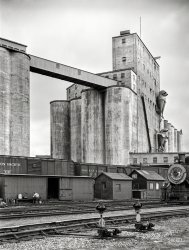
- Machine Car: 1905
- ... appear to be a gravel layer for railroad track beds.
Train wheels Well, it has train wheels and a large hopper bin so my quick guess is that it's a special ... Posted by Dave - 08/21/2012 - 6:29pm -
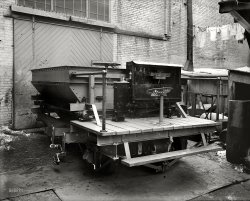
- Arriving at Destination: 1957
- ... people into the windshield.
They shoulda taken the train http://library.duke.edu/digitalcollections/oaaaarchives_AAA6693/ ... Posted by Dave - 11/28/2015 - 7:42pm -
![Arriving at Destination: 1957 Oakland, California, circa 1957, and a compacted Chrysler. We declare Pole S1274 the winner. 4x5 acetate negative from the News Archive. View full size.
An Excellent Exampleof why relatively low speed crashes were once so deadly.
No "accordion" energy-absorbing bumper or cage.
No latch on front seatbacks allowing the seat to drive the passenger and driver into the dash and/or steering wheel. Also, no collapsible steering post or padded dash.
Rear seat cargo or people tended to get hurled forward, further adding to the impact damage. (Obviously, no seat belts.)
Seats tended to be higher than today, elevating people into the windshield.
They shoulda taken the trainhttp://library.duke.edu/digitalcollections/oaaaarchives_AAA6693/
On the plus sideThe steering column kept the driver from going through the windshield.
Chrysler ...Imperial.
Probably not a low speed crashI'm not so sure this was low speed as someone previously commented. To fold a big heavy car up like that I'd say the driver was going at a pretty good clip.
1952 Imperial?Most of the early 50s Chryslers looked pretty similar but I didn't always see the Chrysler script on the hood on models other than 1952
Sorry not SafeI own a 1956 Dodge Coronet, and when people join me for a ride they often comment (because of the vehicle's bulk and relative lack of plastics) that they feel safe compared to today's vehicles. As seen here, they are wrong -- today's vehicles are safer, period.
No thanks.Dave, I probably could do without the photos where someone surely died. Maybe a blurred preview picture with a warning to click if you dare?
My university had four young athletes die in a one car crash into a tree just off the road. This picture gave me a big sad.
[There's nothing wrong with being sad. You'll get over it. As for trigger warnings on 60-year-old photos of empty cars, not gonna happen. - Dave]
Asleep at the wheel?The nighttime shot and lack of skid marks in photo suggest the driver might have been asleep at the time. The Chrysler struck Pole S1274 just inboard of the left front fender. Scrape marks on the pole indicate the car then rotated counter-clockwise. This rotation separated the wheel and tire from the brake and hub assembly with the brake and hub coming to rest in front of the vehicle. The impact location also stiffened the steering column increasing the damage to the driver.
[Asleep, or very drunk. - Dave]
Wrong partJohn J, I think the part that you describe as "the brake and hub" is actually the oil bath air filter still attached to the carburetor. That must have been some impact!
Brake BoosterThe dark object at the base of the pole is the power brake booster and master cylinder, torn loose from the firewall by the imapct. The left front wheel is to the right of the pole, compacted backward into the firewall and almost covered by the crumpled left fender. Note also the right front fender and inner fender assembly over to the left by the men.
EDIT: I agree with another member that the black item is the air cleaner with the carburetor still attached.
Where'd the engine go?At first, I thought it had been driven back into the passenger compartment, but those old Chrysler Firedomes were huge and you'd think some of this one would show. I note what looks a lot like a broken timing chain cover (and maybe a starter motor?) lying some distance in front of the car and wonder if the engine didn't just keep going when the body came to a sudden stop.
That's no brake drumIt's a carburetor with the air cleaner still attached.
(edit: based on Internet pictures it appears to be a Carter one barrel Carb for a 49-54 model, therefore a six cylinder engine)
Other questions to be answered are:
How did the floor mat get on the outside of the vehicle?
What is that plastic sheet looking thing, possibly used to cover the driver until the Coroner (or more optimistically, Ambulance) arrived?
And how did they extract the driver from that mess.
Trolley Pole S1274?Telescoped poles like that were usually for supporting streetcar or trolleybus wires. Back then they were driven into the ground like wood utility poles, so they don't break away like more modern street lights that have sacrificial bolts at ground level. Old concrete light posts and trees became targets for many moving vehicles.
The removal of such "fixed hazardous objects" from the sides of highways certainly made them safer, but unfortunately extending that practice to city and suburban streets encourages faster more dangerous driving, and it puts pedestrians, cyclists, and even children playing in their front lawns in more danger from wayward motorists.
FLASH !Are those flashbulbs in the grass by the driver's door? I think that's a photographer to the left of the pole.
Crumple ZonesTodays modern vehicles have built in "crumple zones" Areas in front of the cowl to absorb collision damage. Even with severe damage to the front end, the damage rarely extends into the passenger compartment. This plus all the other safety items have cut fatalities almost in half since the 50's.
Big EngineI owned (as a work car) a 1952 Imperial with a V8 Hemi engine. A straight eight was also available but no six was in the line-up. The vehicle was as smooth as silk and rode extremely well. The Hemi gave it extraordinary performance, of course. I too am puzzled as to why there is no evidence of the motor. As to the camera in the hands of the other photographer, it is the work-horse of that era, a 4"x5" Speed Graphic.
Out of the PictureGiven the trail of debris and fluids, and the fact that the impact was clearly at the front left quarter, my guess is that the kinetic energy of the moving engine and transmission ripped them off the frame and they are sitting out the picture to the left. Note that the grille and radiator are also nowhere to be seen.
Lost and FoundThe radiator is not missing. Look above the floor mat. It is flat on the ground with a hose sticking up and the filler cap/neck mangled so it also sticks up.
(The Gallery, Cars, Trucks, Buses, News Photo Archive, Signal 30)](https://www.shorpy.com/files/images/SHORPY-792.thumbnail.jpg)
- Bluetooth: 1943
- ... use the grid paper that you see on this desk, to track train movements.
Train Orders This dispatcher is practicing the art of directing rail traffic ... Posted by Dave - 06/01/2009 - 11:27pm -
![Bluetooth: 1943 March 1943. "Amarillo, Texas. Atchison, Topeka and Santa Fe rail dispatcher in the general office." Medium-format negative by Jack Delano. View full size.
Way Out WestLooks like something Wile E. Coyote would get from Acme.
Modern technology?I always find it interesting to see the "technology of the time" in action and to wonder. That man could not possibly imagine what would exist in 2009. Blue Tooth headsets? Trains that run on schedules designed by computers? Excel spreadsheets that are self generated? The mind boggles! High speed trains floating on a cushions of magnets and air?
[The future was more like: The rise of truck freight and the demise of his employer as an independent company; bankruptcy, dissolution and nationalization of the passenger-rail system with the disappearance of the major carriers. - Dave]
Hilarious TitleI laughed out loud when I saw the headline and picture.
Some things are the sameOne of my friends is a dispatcher for a US railroad, and he let me sit in with him one evening. Mostly computerized, of course. Many safety features built in. But they still use the grid paper that you see on this desk, to track train movements.
Train OrdersThis dispatcher is practicing the art of directing rail traffic by the use of train orders, communicating with his order operators by telephone.
The microphone on his chest is activated by a foot pedal while the speaker is an open "party line" to all his operators as well as the offices of yardmasters, wayside telephone boxes, etc. The box in front of him is used to patch in the person he wishes to address. He dictates the orders to one or more operators simultaneously while at the same time writes the orders in his train order book.
To ensure accuracy, each operator reads back the order one by one while the dispatcher underlines each word or number in his book. When the orders are ready to be delivered, the operator (on the Santa Fe) rolls them up and ties them with a string which he attaches to a train order delivery fork.
When the train is approaching his office he will stand a prescribed distance from the track and hold one fork up at the correct height so that the engineman can place his arm through a loop in the string. The operator then takes the second fork and holds it up for the trainman in the caboose or in one of the passenger coaches.
(The Gallery, Jack Delano, Railroads)](https://www.shorpy.com/files/images/8d15329u.thumbnail.jpg)
- Utah Copper Co.: 1942
- ... particular would make a wonderful jigsaw puzzle.
Ore Train That engine looks like a scaled down knockoff of a GG-1. Anyone know ...
Little Engine That Did The engine pulling the ore train is a steeple-cab with an articulated frame that has four wheels (two ... Posted by Dave - 08/30/2012 - 4:47pm -
![Utah Copper Co.: 1942 November 1942. Bingham Canyon, Utah. "Open-pit workings of the Utah Copper Company. This is the Carr Fork side, from which the company obtains huge amounts of ore. The Carr Fork bridge and main shops appear in the foreground." 4x5 Kodachrome transparency by Andreas Feininger. View full size.
The Second Time AroundI thought I'd seen this mine featured here before now.
https://www.shorpy.com/node/4463
Incredible epic pictureThe detail is amazing.
WowEpic proportions.
In the Gift ShoppeYou should add a "jigsaw puzzle" option to the print sales business; this photo in particular would make a wonderful jigsaw puzzle.
Ore TrainThat engine looks like a scaled down knockoff of a GG-1. Anyone know what it is?
Massive Mystery MineWhile on a trip to the west coast about 30 years ago, I snapped this shot of an open pit mine, name unknown. I've never located it despite lots of Googling. I suspect it is in Arizona or New Mexico.
Thanks to shooting through a badly-etched window, the scene was given a somewhat psychedelic colorized effect.
[A number of commenters ID this as the Sacaton (Casa Grande) copper mine south of Phoenix. - Dave]
Thanks to everyone for solving my mystery after all these years!
Electric locomotivesThe electric locomotive in this scene is known as a "steeplecab" and was a common type used in interurban and industrial freight service in the teens and '20s. The Bingham Canyon mine used many of these over the years and several have been preserved at museums. Here's one: http://www.davesrailpix.com/wrm/htm/wrm045.htm
Little Engine That DidThe engine pulling the ore train is a steeple-cab with an articulated frame that has four wheels (two axles) on each part. These were very heavy locomotives and I believe that they built for this application only.
Coincidently, the towers holding the overhead (trolley) wire could be moved could be moved when the track arrangement was changed to access the changing ore deposits.
General ElectricsI believe the engine in the foreground is a (General Electric) GE 90-ton electric. The Bingham Utah Copper Mine received four of these engines in February 1942 and were lettered for Kennecott Copper Corporation. They were numbered KCC 761,KCC 762,KCC 763,and KCC 764.
Where do we go?!About 100 feet in front of the ore train are 3 men and a push cart. I assumed the locomotive was pulling but for these guys' sakes I hope it's pushing!
The EngineThe locomotive is a fairly standard Steeplecab design. The design - two powered axles on each truck - was pretty ubiquitous on electric lines worldwide.
(The Gallery, Kodachromes, Andreas Feininger, Mining)](https://www.shorpy.com/files/images/1a34852u.thumbnail.jpg)
- Honeymoon Train
- ... Chagnon leaving for their honeymoon in 1930 from the train station in New London, CT
Just Married What a sweet photo! They ... Posted by saturnsixx - 06/02/2007 - 12:17am -
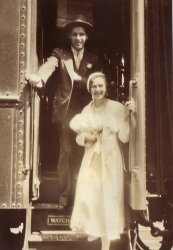
- Merry Christmas: 1951
- ... There were some years we hated her.
My first electric train And a red AMT '51 Pontiac were under our tree on Christmas 1951! Wish ... Posted by Dave - 12/25/2017 - 10:32am -
![Merry Christmas: 1951 A Christmas chestnut from the Tuttle attic:
"Tree -- Dec. 25, 1951." Merry Christmas from Blue Earth, Minnesota, and from Shorpy! 35mm Kodachrome by Grace or Hubert Tuttle. View full size.
Tinsel on the treeAnd snow on the ground.
The Box!What jumped out at me about this picture was the Campbell's Soup box! I remember having these at home with stuff stored in them. A product of the days when people would go and get empty boxes from the back of the grocery store to use for storage.
Tinsel perfectionistWould have made my sister proud; whilst my brother and I preferred to throw handfuls at the tree; she always insisted on draping them one strand at a time.
There were some years we hated her.
My first electric trainAnd a red AMT '51 Pontiac were under our tree on Christmas 1951! Wish I had both back!
At Last!Something that can compete with the wallpaper!
Takes hours to wrap, minutes to destroyMy eldest sister's first job was at a department store in the gift wrap department. She is now in her middle 60s. To this day, when I receive a present from her, it is wrapped to perfection, taped and ready for presentation.
These presents remind me of her skills. As a man, I really prefer the gift bags with tissue paper.
1950s OrnamentsWe have some of the same ones (notably the glass birds with the glass fibre tails) on our tree, handed down and carefully preserved. A nice reminder of Christmas growing up in the '50s.
Merry Christmas Shorpyites!
The plant standAnybody notice the plant in a Calumet baking soda can?
Fire Hazard ReductionAlas, no wax candles, as far as I can tell.
Being traditionalists, my parents didn't go electric until the late 1970ties.
The smell of real beeswax candles on a real tree is unsurpassed. As well as the arrangement and re-arrangement of the candle holders until daddy was satisfied that all candles well were clear from any branch above. Which took hours. Not to mention daddy's hawkeyed supervision of his kids dearest lighting those candles on X-mas eve. Once. With all due care. And him not leaving the living room until the candles were out again.
Soup boxI assumed the soup box is how the relatives brought over the presents and they just hadn't gotten around to unloading them before the picture was taken.
We used boxes like these when we went camping.
Christmas TreeEven today when I think of Christmas trees this is what I think of. All through the 50's and 60's this was the only type that were usually sold in the Houston area. I was even a little mad when one Christmas season I was very sick and my mom went out and got a tree for my apartment and she got a spruce instead of a "real" Christmas tree.
What is Real?Is it then or now. Most kids today might say sometime in the future that their parents had "real" Christmas trees that were hand made in China.
Up until the first 'fake' Christmas tree, there were only real ones. I remember the smell of pine and my grandma saying "Now dear, do not touch the tree if you do not want to get sappy"
I guess in the end I am still sappy, but only about Christmas memories like this one from Shorpy.
[This blue spruce reminds your webmaster of his own childhood! - Dave]
Blue Earth on ChristmasThank you, Shorpy. I didn’t realize how much I needed some of the Tuttle family for Christmas until I saw this image today. The Blue Earth series is my favorite. Merry Christmas to all, and thanks again for being a part of my daily life.
PerfectHere's wishing that the entire Shorpy family is having a wonderful Christmas Day Thank you, Dave
Full TreesLiving overseas in the 50s. I remember my parents and my aunt and uncle getting three real trees. One would go to them, one for us. The third was used to fill out the other two.
And they were big. Or I was little!
The tinsel is what always got me. When taking the trees down, we could not just put the decorations away. No, we had to preserve the tinsel. We could not buy it where we lived. To get more in time for Christmas, would have to get in the middle of summer in the US. Not worth it.
We also had to preserve the wrapping for the same reason.
What we did not have was that white stuff you can see thru the window. Never did experience a white Christmas until I was 16.
Thanks for the memories.
Tree memoriesThis is exactly what out trees used to look like in the 60's.
The mismatched ornaments, the Santa, the Stars, the indented ornaments, the Tinsel, the green & red wiring running all over and of course the Topper!
(Christmas, Minnesota Kodachromes)](https://www.shorpy.com/files/images/SHORPY-MNK146.thumbnail.jpg)
- R.F.K., R.I.P.: 1968
- ... F. Kennedy." Thousands of people lined the tracks as the train carrying RFK's casket made the eight-hour journey from his funeral in New ... me the exact spot.
A further tragedy As the funeral train approached Elizabeth, New Jersey, two people who were standing on an ... Posted by Dave - 05/13/2013 - 8:54pm -
![R.F.K., R.I.P.: 1968 June 8, 1968. "Funeral cortege of Robert F. Kennedy." Thousands of people lined the tracks as the train carrying RFK's casket made the eight-hour journey from his funeral in New York to Washington, D.C. 35mm Kodachrome transparency. From photos by Paul Fusco and Thomas Koeniges for Look magazine. View full size.
CurlersThat was a common thing, to go out before your curls had set, and the butt of not a few jokes. Nobody does that anymore. Do they even still make curlers?
In the '80s, my dad worked next door to the Ambassador Hotel, where RFK was shot. I remember him taking me there and showing me the exact spot.
A further tragedyAs the funeral train approached Elizabeth, New Jersey, two people who were standing on an adjacent track to get a view of the funeral train were fatally struck by another train.
Two SidesWonder what the people looked like on the other side of the tracks.
Photographed From?Was this taken from the moving train, or from across the tracks?
Something Happening HereFusco's photos from the RFK funeral train (published in book form for the first time a few years ago) present a deeply moving group portrait of a specific instant in American history. You feel all of the country is on display, united, fleetingly, in confusion and grief. The blurred backgrounds, which contribute so much to the sense of the world unfurling outside the train window, were the unwanted but inescapable result of the ASA 25 film he was using.
Between this post and the previous two, there's a James Ellroy novel in the making.
Re: Photographed From?Definitely from the moving train.
As Hackensacker commented on the slow 35mm film, the blurred background is a result of the photographer panning the shot to keep the mid-ground people fixed in the frame. You can see a lesser degree of lateral blurring in the foreground foliage, as well.
Time warpI thought Kennedy was assassinated in 1963.
[Yes. -tterrace]
On display to the world "You feel all of the country is on display..."
Yes. When RFK was killed, my parents were stationed by the Foreign Service in Europe; we were in a restaurant in England right after we found out about the shooting, and there was a strong buzz of comments on the order of "These Americans shooting everyone who matters." The comments were genuinely aghast and puzzled, not mean spirited, but we were for sure on display to the world. Martin Luther King had just been shot at a moment when his fame and importance were growing overseas, and I had just been in a rather small "race riot" of demonstrations after his shooting; not a real riot, but exciting and disturbing stuff in my college town of Carlisle, Pennsylvania. As with JFK in 1960, RFK and MLK were overwhelmingly popular overseas, far more so than in there own country. I felt like a citizen of a surreal pariah nation that summer.
Three KennedysMr. WMtraveler. You are correct, but not totally right. There were three Kennedy Brothers, John (Jack), Robert (Bobby) and Edward (Teddy). Two of them were assassinated, John in 1963 and Robert in 1968.
[There were four Kennedy brothers. -tterrace]
Final, 60's version of a tradition?What a wonderful photo of the last gasp of funeral trains and of public observance of such grief. Very 60's. Can't recall any major public funeral trains after this one.
Elizabeth, NJ AccidentI was there. The crowd was so large I climbed a fence with a pole alongside. Stood on top of the fence with one arm around the pole, the other holding my camera.
Platforms were ground level and the crowd moved onto the tracks to get a view of the special train. "The Admiral",an express train heading to New York City from Chicago came around the curve just south of the station. "The Admiral's" GG1 locomotive sounded its horn,a long loud blast, but some of the people in the crowd did not clear the track in time and sadly two were killed and four seriously injured.
After the tragic accident the Penn Central ordered all train movement stopped until the special train passed. The funeral train arrived in Washington's Union Station four hours behind schedule and had caused disruption to the entire railroad.
RFK funeral trainDear all, (and AndyB who posted on 05/16/2013) can you please contact me? I would love to get in touch with bystanders of their relatives, who stood alongside the tracks and made photos or films of the funeral train of Robert F. Kennedy. As a Dutch photographer and teacher I am doing research on photography and memory. Even though I do work and live in the Netherlands, I sense that this event will still arouse vivid memories in the minds of many Americans. The images I am looking for don't have to be perfect, any visual material is welcome. I will gladly credit your photos and films wherever they’re used and I can compensate the potential expenses you need to make in digitizing the pictures. If you wish to learn more about my call, please, let me know. Thank you very much in advance for any kind of assistance!
Yours faithfully,
Rein Jelle Terpstra mail@reinjelleterpstra.nl
(LOOK, Railroads)](https://www.shorpy.com/files/images/SHORPY_22336u.thumbnail.jpg)
- Train Photo 1
- I purchased many train and related photos at an estate sale. I have little info except dates on ... Posted by Philigan - 09/10/2016 - 9:56am -
























